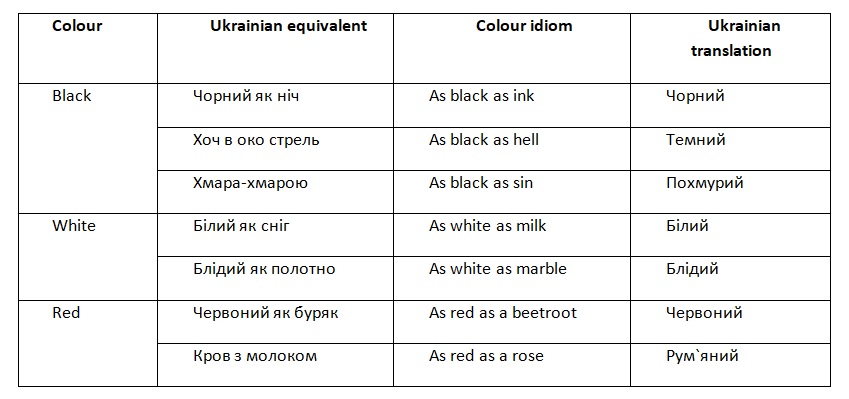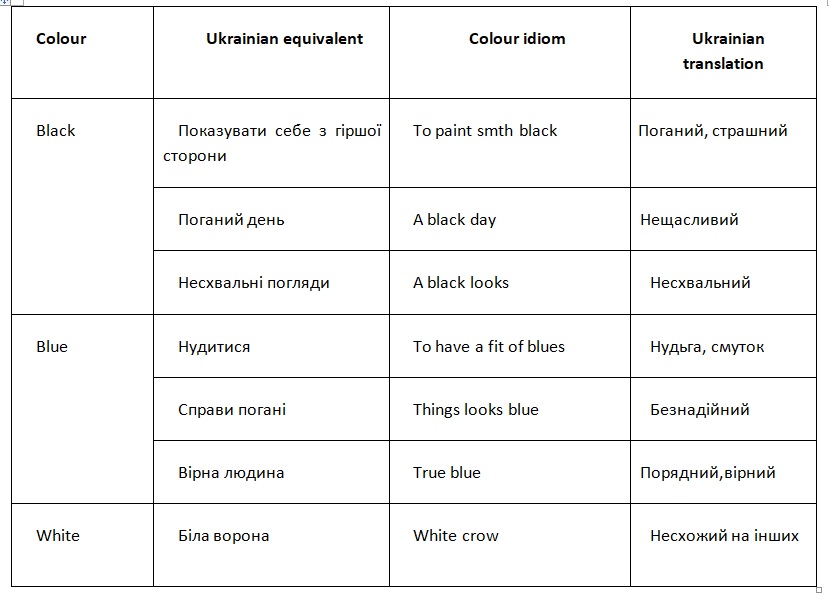Лещенко А.В. Ідіоми із застосуванням назв кольорів у сучасній англійській мові
Матеріал з PSYH.KIEV.UA -- Вісник психології і соціальної педагогіки
Лещенко А. В. – студентка Педагогічного інституту Київського університету імені Бориса Грінченка, спецільність « Дошкільна освіта», кафедра іноземних мов і методик їх навчання Київського університету імені Бориса Грінченка
Анотація: У статті розглянуто сучасні ідіоми з застосуванням назв кольорів та особливості їх перекладу. Автор робить розробки класифікації ідіом згідно з особливостями їх перекладу з англійської на українську мову.
Ключові слова: ідіома, фразеологізм, переклад, ідіомa кольору
Аннотация: В статье рассмотрены современные идиомы с применением названий цветов и особенности их перевода. Автор разрабатывает классификации идиом согласно особенностям их перевода с английского на украинский язык.
Ключевые слова: идиома, фразеологизм, перевод, идиома цвета
Annotation: This article examines the specifics of color idioms translation from English into Ukrainian. The author highlights the idioms classification according to the peculiarities in their translation
Key words: idiom, phraseological unit, idiom translation, color idiom
Зміст |
Problem setting
English is the most popular language in the world. Nowadays English is spoken practically all over the world. We must learn English to find a common language with other people. When you learn English you discover new possibilities. Every day you learn new words and phrases to express your felling and emotions. But every language as well as English is full of expressions and idioms which make the language more interesting and individual. So while learning English we should learn idioms, but it requires a great attention and efforts.
Analysis of recent achievements and publications
Many scientists do their researchers studying colour idioms and their usage and formation. They are: A. Alekhina, M. Alefirenko, N. Amosova, V. Mokienko, E. Polivanov, O. Smirnickiy. A major stimulus to intensive studies of phraseology in linguistics was N. Rayevskaya’s research carried out relating to cast-iron idioms or phraseological fusions in the English language. A special point of interest observed by the approach to the problem of phraseology suggested by a famous philologist N. Amosova who defines phraseological units as units of fixed context.
The objective of the article
In our research, we try to give the characteristics of the colour idioms in modern English vocabulary, to identify their features; make the colour idioms classifications and give examples of them; to help students overcome the difficulties of colour idioms learning in the English language while learning English.
The statement of the fundamental material
Idioms are important because they are very common. It is impossible to speak, read or listen to English without idiomatic language. Every native speaker English is idiomatic. Every newspaper is full of metaphorical language. You cannot avoid it or leave it till later. Very often the metaphorical use of a word is more common today than its literal use. Often the literal meaning creates a picture in your mind and this picture makes the other meanings easier to understand. Colour idioms are important because they are fun to learn and to use. Because there is so much to learn, anything which helps you to remember things is important and if the language you are learning is more colorful and interesting, there is more chance that you will remember it. You will also sound more natural if your English contains more idioms. When we study colour idioms we improve our foreign language skills. The majority of colour idioms are tightly connected with the human and different fields of his activity that caused the emergence of a thematic group of idioms.
An idiom is a fixed phrase which is only meaningful as a whole. It means something different from the meanings of the separate words from which it is formed [1, p. 29]. An idiom is an expression with the following features. It is fixed and is recognized by native speakers. You cannot make up your own! It uses language in a non-literal – metaphorical – way. Can we translate idioms? The simplest answer to this question is NO. This is an area where languages can be very different. Never translate an idiom word for word. You must translate the whole expression. Sometimes you will be able to translate the English idiom into an idiom in your own language. However, there may be no idiom and you may just have to explain the meaning. Jon Wright compiled «Idioms organizer», where he gives different classifications and examples of English idioms [3]. All languages have colour idioms. Native speakers of a language acquire these idioms from a very early stage in their linguistic development, and learn and remember them as a complete item, rather than a collection of separate words. The study showed, in the English language the most numerous are black colour idioms (black books, the black dog) (of 24.71 %). In the second place blue colour idioms are (blue rose, blue funk) (of 16.86 %). Next in descending order white colour idioms are (white liver, white man)(15.01%); red colour idioms (as red as a poppy, red in the face) (14.31%); green colour idioms (green goods, as green as grass) ( 9.47%); yellow colour idioms (yellow jacket, yellow jack) ( 6.47%); rosy and pink colour idioms ( to be in the pink) (3.24%); grey colour idioms (as grey as a bat`s wing)( 2.78%); brown colour idioms (brown study) (2.54%); then purple colour idioms (0.69%); and orange colour idioms (0.23%).
Colour idioms very often contain metaphors, but not always. They have connotative meanings which can be specific to particular area of life and can differ across cultures. In addition, connotative meanings of colours are incorporated into conventional linguistic expressions such as to feel blue (= feel sad), to be in the pink (= to be in the best condition), and to see red (= become angry very rapidly) in English, and in Persian white beard (= experienced and knowledgeable/wise man), white eye (= impudent; impertinent person), black fortune (= bad fortune) [2]. Phraseological units, containing the name of the colour, can be clasificated according to the structure types. We find out comparison idioms, metaphor idioms, metonym idioms.
Comparison idioms usually have in the literal meaning. The examples are given in the table below:
Metaphor idioms are usually formed with priority of imagination.
Metonym idioms. There are several groups of metonym idioms:
1) phraseological units denoting people describing their clothes: black coat (priest, pop), red coat (British soldier), the blue-coat boy (a noble disciple of the school), black shirt (a fascist), blue jacket (sailor of the English Navy), black gown (Catholic priest); the red hat (title of cardinal).
2) phraseological units describes different state ( not colour): the green cloth (більярдний стіл),black letter (старовинний англійський готичний шрифт), black literature (книги з готичним шрифтом), white letter (латинський шрифт). A number of proverbs and idiomatic phrases can be found not only in English but in the Ukrainian, Russian, French, German and other European languages. Here are a few examples of them: in English – To be born with a silver spoon in one’s mouth (syn. To be born under a lucky star) means to be born into a very wealthy family in Ukrainian – «народитися у сорочці» and in Russian it sounds «родился в рубашке».
Conclusion and the prospects of the above research
Everything mentioned above confirms that the studying of the colour idioms phenomenon in English in the process of learning a foreign language is extremely useful, as it provides an opportunity to get acquainted with the world of phrases and English-speaking communicators. Idioms help us to freely еxpress our emotions and feelings. Knowledge of idioms helps us to find a common language with other people. Еvery day we can add to our vocabulary these phrases and become successful. We can impart our knowledge and skills to others and change the world for the better. So, the colour idiom classification given in this article can make the learning process easier and help to remember students colour idioms using different characteristics and idiom description, creating useful associations and organizing the learning process more interesting and progressive.
References
- Єфімов Л.П. Стилістика англійської мови і дискурсивний аналіз. Учбово-методичний посібник / Єфімов Л. П., Ясінецька О. А. – Вінниця: НОВА КНИГА, 2011. – 240 с.
- Kucheryava J. О. The phenomenon of colou ridioms in English [Електронний ресурс] – Режим доступу до ресурсу: http://pi.kubg.edu.ua/resursi/elektronni-vydannia/2016-01-06-12-17-03.html
- Wright J. Idioms organizer / Jon Wright. – United States: THOMSON HEINLE, 2002. – 294 с.

